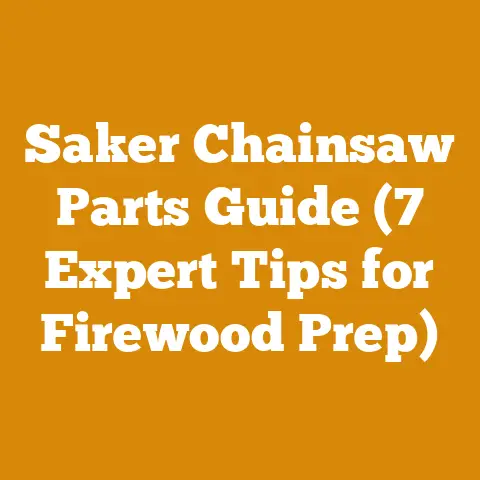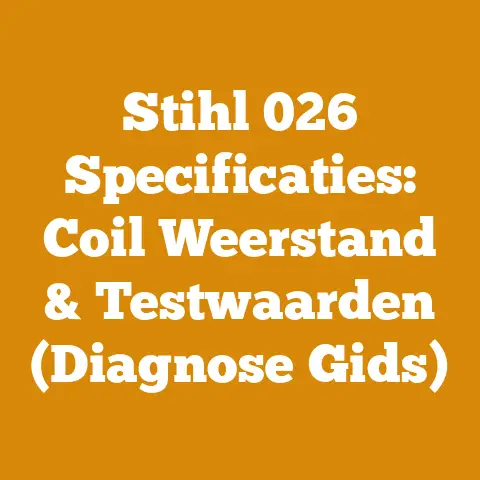27000 Buck Stove Damper Repair Tips (Fixing Vintage Stove Issues)
Introduction: The Heart of the Hearth – Restoring a Vintage Buck Stove
There’s a certain magic to a wood-burning stove. It’s more than just a heat source; it’s a focal point, a gathering place, a comforting presence on cold winter nights. For many, like myself, that magic is amplified when the stove in question is a vintage Buck Stove. These stoves, built with a robust design and a classic aesthetic, hold a special place in our hearts. However, time and use can take their toll, and one of the most common issues I encounter is a malfunctioning damper.
I’ve spent years working with wood, from felling trees in the crisp autumn air to meticulously stacking firewood for optimal drying. I’ve learned firsthand the importance of a properly functioning stove, not just for heating efficiency but also for safety. A damaged or inoperable damper can lead to a host of problems, including inefficient burning, excessive smoke, and even dangerous carbon monoxide buildup.
This guide is born out of my experience and a desire to help others keep these vintage beauties burning brightly. We’ll delve into the intricacies of Buck Stove damper repair, providing practical tips and step-by-step instructions to get your stove back in top shape. Whether you’re a seasoned woodworker or a complete novice, this guide will equip you with the knowledge and confidence to tackle this essential repair.
This guide will cover:
- Understanding the Buck Stove Damper System: How it works and why it’s crucial.
- Identifying Damper Problems: Diagnosing common issues and their symptoms.
- Essential Tools and Materials: Gathering the right equipment for the job.
- Step-by-Step Repair Guide: Detailed instructions for various damper repairs.
- Preventative Maintenance: Keeping your damper in good working order.
- Safety Considerations: Prioritizing safety throughout the repair process.
- Troubleshooting Common Issues: Addressing unexpected problems during repair.
Understanding the Buck Stove Damper System
Before diving into the repair process, it’s crucial to understand the function of the damper and its role in the overall operation of your Buck Stove.
What is a Damper?
The damper is essentially a movable plate or valve within the stove’s flue or chimney. Its primary function is to regulate the airflow through the stove and up the chimney. By adjusting the damper, you control the rate at which air enters the firebox, influencing the combustion process and the amount of heat produced.
How Does it Work?
- Open Damper: When the damper is fully open, it allows maximum airflow. This results in a hotter, faster-burning fire, ideal for quickly heating a cold room. However, it also means more heat escapes up the chimney, reducing overall efficiency.
- Closed Damper: Closing the damper restricts airflow. This slows down the burn rate, conserving fuel and allowing more heat to radiate into the room. However, closing the damper too much can lead to incomplete combustion, producing excessive smoke and potentially dangerous carbon monoxide.
- Modulating the Damper: The key is to find the sweet spot – the damper setting that provides a balance between heat output, fuel efficiency, and clean burning.
Why is it Important?
The damper is a critical component for several reasons:
- Controlling Burn Rate: As mentioned, it directly affects how quickly your wood burns.
- Maximizing Heat Output: By regulating airflow, you can optimize the amount of heat radiated into the room.
- Improving Fuel Efficiency: Proper damper control can significantly reduce wood consumption.
- Preventing Smoke Backdraft: A properly functioning damper helps maintain a strong draft, preventing smoke from entering the room.
- Ensuring Safe Operation: Incomplete combustion due to improper damper settings can lead to carbon monoxide poisoning.
Buck Stove Damper Types
Vintage Buck Stoves primarily utilized two main types of dampers:
- Butterfly Damper: This is the most common type. It consists of a circular or rectangular plate that pivots on a central axis within the flue pipe. A lever or handle is used to rotate the plate, opening or closing the damper.
- Sliding Damper: Less common, this type features a plate that slides horizontally or vertically within the flue. While simple, it’s often less precise than a butterfly damper.
Damper Location
The damper is typically located in one of two places:
- Within the Stove Body: Some Buck Stoves have the damper integrated into the stove’s upper section, just before the flue pipe connection.
- Within the Flue Pipe: In other models, the damper is located within the flue pipe itself, close to the stove.
Knowing the type and location of your damper is essential for accurate diagnosis and repair.
Identifying Damper Problems
Recognizing the signs of a malfunctioning damper is the first step towards fixing the problem. Here are some common symptoms and their potential causes:
Difficulty Opening or Closing the Damper
- Rust or Corrosion: Over time, rust can accumulate on the damper plate and its mechanism, making it difficult to move. I’ve seen this happen frequently, especially in stoves that haven’t been used for extended periods or exposed to moisture.
- Debris Buildup: Soot, creosote, and other debris can accumulate around the damper, obstructing its movement. Regular cleaning is essential to prevent this.
- Warped Damper Plate: Extreme heat can sometimes warp the damper plate, causing it to bind against the flue walls.
- Damaged Linkage: The linkage connecting the damper handle to the plate can become bent or broken, preventing proper operation.
Damper Doesn’t Stay in Position
- Loose Handle or Mechanism: The handle or locking mechanism may be loose, allowing the damper to drift out of position.
- Worn Friction Pads: Some dampers use friction pads to hold them in place. These pads can wear out over time, reducing their effectiveness.
- Damaged Damper Plate: If the damper plate is bent or warped, it may not seat properly, causing it to move unintentionally.
Excessive Smoke or Poor Draft
- Damper Stuck Closed or Partially Closed: This is a common cause of smoke backdraft and poor draft.
- Air Leaks Around Damper: Even when closed, a damaged or poorly fitting damper can allow excessive air to enter the flue, disrupting the draft.
- Chimney Obstruction: While not directly related to the damper, a blocked chimney can also cause similar symptoms. Always check your chimney for obstructions before assuming the damper is the sole problem.
Inefficient Burning
- Damper Stuck Open: A damper stuck in the open position will cause the fire to burn too quickly, wasting fuel and reducing heat output.
- Air Leaks Around Damper: As mentioned above, air leaks can disrupt the combustion process, leading to inefficient burning.
Unusual Noises
- Squeaking or Grinding: This often indicates rust or debris buildup in the damper mechanism.
- Rattling: A loose damper plate or damaged linkage can cause rattling noises.
Case Study:
I once worked on a Buck Stove where the owner complained of excessive smoke and difficulty starting fires. Upon inspection, I found that the butterfly damper was heavily corroded and stuck in a partially closed position. The rust had essentially fused the damper plate to the flue walls. After a thorough cleaning and lubrication, the damper moved freely, and the stove operated as expected. This highlights the importance of regular maintenance in preventing such problems.
Essential Tools and Materials
Before starting any repair work, gather the necessary tools and materials. Having the right equipment on hand will make the job easier, safer, and more efficient.
Safety Gear
- Work Gloves: Protect your hands from sharp edges, rust, and grime.
- Safety Glasses: Shield your eyes from dust and debris.
- Dust Mask or Respirator: Protect your lungs from soot and creosote particles.
- Hearing Protection: If using power tools, wear earplugs or earmuffs.
Hand Tools
- Screwdrivers (Various Sizes): Phillips head and flathead screwdrivers are essential for removing screws and fasteners.
- Wrenches (Adjustable and Socket Set): Needed for loosening and tightening nuts and bolts.
- Pliers (Needle-Nose and Slip-Joint): Useful for gripping, bending, and manipulating small parts.
- Wire Brush: For removing rust and debris from the damper and its mechanism.
- Scraper: For removing stubborn soot and creosote buildup.
- Hammer: For gently tapping components into place.
- Penetrating Oil (e.g., WD-40): To loosen rusted or stuck parts.
- Measuring Tape: For measuring and marking.
Power Tools (Optional but Recommended)
- Drill with Wire Brush Attachment: Speeds up the rust removal process.
- Angle Grinder with Wire Wheel: For more aggressive rust removal.
- Welder (for advanced repairs): If the damper plate or linkage is severely damaged, welding may be necessary.
Materials
- High-Temperature Lubricant: Specifically designed for stove components, this lubricant will withstand high temperatures and prevent rust.
- Replacement Damper Plate (if needed): If the existing damper plate is beyond repair, you’ll need a replacement.
- Replacement Linkage (if needed): Similarly, if the linkage is damaged, you’ll need a replacement.
- High-Temperature Stove Paint (optional): To touch up any areas where paint has been damaged during the repair.
- Rags or Paper Towels: For cleaning and wiping.
- Sandpaper (various grits): For smoothing rough surfaces.
- Fire Cement (for sealing leaks): To seal any air leaks around the damper or flue pipe.
Wood Selection & Measurement Tools
- Moisture Meter: Crucial for determining the moisture content of your firewood. Ideally, firewood should be seasoned to a moisture content of 20% or less for efficient burning.
- Measuring Tape/Ruler: For accurately measuring firewood lengths. I typically cut my firewood to 16-18 inches to fit comfortably in my stove.
- Wood Type Guide: Familiarize yourself with the burning characteristics of different wood types. Hardwoods like oak, maple, and ash provide more heat and burn longer than softwoods like pine and fir. I personally prefer oak for its high heat output and long burn time.
Safety First
- Always wear appropriate safety gear.
- Disconnect the stove from the flue pipe before starting any work.
- Work in a well-ventilated area.
- If you’re not comfortable with any of the repair steps, consult a qualified professional.
Step-by-Step Repair Guide
Now that you’ve gathered your tools and materials, let’s move on to the repair process. This guide covers some of the most common damper problems and their solutions.
1. Cleaning and Lubrication
This is often the first and simplest step, and it can resolve many damper issues.
- Disconnect the Flue Pipe: Carefully disconnect the flue pipe from the stove.
- Access the Damper: Depending on your stove model, you may need to remove a panel or access the damper from inside the firebox.
- Remove Debris: Use a wire brush and scraper to remove any soot, creosote, or rust from the damper plate and its surrounding area. Pay close attention to the pivot points and any moving parts.
- Apply Penetrating Oil: Spray penetrating oil on any rusted or stuck parts. Let it soak for a few minutes to loosen the rust.
- Work the Damper: Gently try to move the damper back and forth. If it’s still stiff, apply more penetrating oil and repeat the process.
- Lubricate: Once the damper moves freely, apply a high-temperature lubricant to the pivot points and any other moving parts.
- Reassemble: Reconnect the flue pipe to the stove.
Personal Experience:
I’ve found that a good wire brush and some elbow grease can often work wonders. I once resurrected a damper that was completely seized by spending an hour meticulously cleaning and lubricating it. The owner was amazed that it didn’t require any replacement parts.
2. Damper Plate Repair
If the damper plate is warped or damaged, it may need to be repaired or replaced.
- Inspect the Damper Plate: Carefully examine the damper plate for any cracks, bends, or warps.
- Straighten Bent Plate (if possible): If the plate is only slightly bent, you may be able to straighten it using a hammer and a flat surface. Be careful not to crack or break the plate.
- Weld Cracks (if applicable): If the plate has cracks, you can weld them shut using a welding machine. This requires some welding experience.
- Replace Damper Plate (if necessary): If the plate is severely damaged or beyond repair, you’ll need to replace it. You can often find replacement damper plates online or at your local stove shop. Make sure to get the correct size and type for your stove model.
- Install Replacement Plate: Follow the manufacturer’s instructions for installing the replacement damper plate.
3. Linkage Repair
The linkage connects the damper handle to the damper plate. If the linkage is bent or broken, the damper won’t function properly.
- Inspect the Linkage: Examine the linkage for any bends, breaks, or loose connections.
- Straighten Bent Linkage (if possible): If the linkage is only slightly bent, you may be able to straighten it using pliers.
- Replace Damaged Linkage: If the linkage is broken or severely bent, you’ll need to replace it. You can often find replacement linkage kits online or at your local stove shop.
- Install Replacement Linkage: Follow the manufacturer’s instructions for installing the replacement linkage. Ensure that all connections are secure.
4. Sealing Air Leaks
Air leaks around the damper can disrupt the draft and reduce the stove’s efficiency.
- Identify Air Leaks: Light a stick of incense and hold it near the damper and flue pipe connections. If the smoke is drawn towards a particular area, it indicates an air leak.
- Apply Fire Cement: Apply fire cement to any cracks or gaps around the damper and flue pipe connections. Fire cement is a heat-resistant sealant that will prevent air from leaking into the stove.
- Allow to Cure: Allow the fire cement to cure according to the manufacturer’s instructions before using the stove.
5. Firewood Preparation: A Quick Guide
While repairing your damper is crucial, proper firewood preparation is equally important for efficient and safe stove operation.
- Seasoning: Green wood contains a high moisture content, which makes it difficult to burn and produces excessive smoke. Seasoning involves drying the wood for at least six months, preferably longer, to reduce its moisture content.
- Splitting: Splitting firewood increases its surface area, allowing it to dry faster and burn more efficiently. I use a hydraulic log splitter for larger logs, but a good splitting maul works well for smaller pieces.
- Stacking: Stack firewood in a way that allows for good air circulation. I prefer to stack my firewood in rows, with gaps between the rows and the ground, to promote drying.
Tool Specifications and Wood Type Selection
Chainsaw: I use a Stihl MS 271 Farm Boss chainsaw for felling trees and bucking logs. It has a 20-inch bar and a powerful engine, making it suitable for a variety of wood types.
Axe: For splitting smaller pieces of firewood, I use a Fiskars X27 splitting axe. It’s lightweight and has a well-designed head that makes splitting easier.
Log Splitter: For larger logs, I rely on a 25-ton hydraulic log splitter. It significantly reduces the effort required to split tough hardwoods like oak.
Wood Types:
- Oak: High heat output, long burn time, produces minimal smoke.
- Maple: Good heat output, moderate burn time, produces minimal smoke.
- Ash: Good heat output, moderate burn time, easy to split.
- Pine: Lower heat output, short burn time, produces more smoke. I generally avoid burning pine in my stove due to its high resin content, which can contribute to creosote buildup.
Moisture Content Targets:
- Optimal: 15-20%
- Acceptable: 20-25%
- Unacceptable: Above 25%
Preventative Maintenance
Once you’ve repaired your damper, it’s essential to implement a preventative maintenance plan to keep it in good working order.
- Regular Cleaning: Clean the damper and its surrounding area at least once a year, or more frequently if you burn a lot of wood.
- Lubrication: Lubricate the damper mechanism with high-temperature lubricant every year.
- Inspect for Damage: Regularly inspect the damper plate and linkage for any signs of damage.
- Chimney Sweeping: Have your chimney professionally swept at least once a year to remove creosote buildup. Creosote is a highly flammable substance that can cause chimney fires.
Case Study:
I once neglected to clean my damper for several years, and it eventually became so clogged with creosote that it was completely unusable. I had to spend several hours carefully cleaning it to restore it to working order. This experience taught me the importance of regular maintenance.
Safety Considerations
Safety should always be your top priority when working on your Buck Stove.
- Wear Safety Gear: Always wear work gloves, safety glasses, and a dust mask or respirator.
- Work in a Well-Ventilated Area: Avoid working in enclosed spaces where carbon monoxide can accumulate.
- Disconnect the Stove: Disconnect the stove from the flue pipe before starting any work.
- Let the Stove Cool Down: Allow the stove to cool down completely before starting any repairs.
- Use Caution with Power Tools: If using power tools, follow the manufacturer’s instructions carefully and wear appropriate hearing protection.
- Consult a Professional: If you’re not comfortable with any of the repair steps, consult a qualified professional.
Troubleshooting Common Issues
Even with careful planning and execution, you may encounter unexpected problems during the repair process. Here are some common issues and their solutions:
- Damper Plate Stuck Solid: If the damper plate is completely seized, try applying more penetrating oil and using a hammer to gently tap around the plate. You may also need to use a heat gun to loosen the rust.
- Stripped Screws: If you strip the head of a screw, try using a screw extractor to remove it. You can also try using a rubber band or steel wool to improve the grip of your screwdriver.
- Broken Bolts: If you break a bolt, try using a bolt extractor to remove it. You may also need to drill out the bolt and use a tap to re-thread the hole.
- Difficulty Finding Replacement Parts: If you’re having trouble finding replacement parts for your stove, try contacting a local stove shop or searching online. You may also be able to find used parts on online auction sites.
Strategic Insights and Tactical Instructions
Beyond the specific steps of damper repair, consider these broader strategic insights:
- Long-Term Investment: Maintaining your Buck Stove is an investment in your home’s heating system and your comfort.
- Knowledge is Power: Understanding how your stove works empowers you to troubleshoot problems and perform necessary repairs.
- Community Resources: Don’t hesitate to connect with other Buck Stove owners online or in your community. Sharing experiences and tips can be invaluable.
- Professional Guidance: When in doubt, seek the advice of a qualified stove technician. They can provide expert diagnostics and repairs.
Practical Next Steps and Implementation Guidance
Now that you’ve learned about Buck Stove damper repair, here are some practical next steps:
- Assess Your Stove: Inspect your damper and identify any problems.
- Gather Your Tools and Materials: Assemble the necessary equipment.
- Follow the Repair Guide: Work through the steps outlined in this guide.
- Implement Preventative Maintenance: Establish a regular maintenance schedule.
- Enjoy Your Restored Stove: Relax and enjoy the warmth and comfort of your vintage Buck Stove.
Conclusion: Keeping the Flame Alive
Restoring a vintage Buck Stove is a rewarding experience. It’s a chance to connect with the past, preserve a piece of history, and enjoy the unique warmth and character of a classic wood-burning stove. By understanding the damper system, identifying common problems, and following the steps outlined in this guide, you can keep your Buck Stove burning brightly for years to come. Remember, safety is paramount, and preventative maintenance is key to long-term performance. With a little effort and dedication, you can ensure that your vintage Buck Stove remains a cherished part of your home for generations. I hope this guide helps you to keep your fire burning safely and efficiently!






